Photography Tips
by Michael Frye | Dec 20, 2013 | Photography Tips
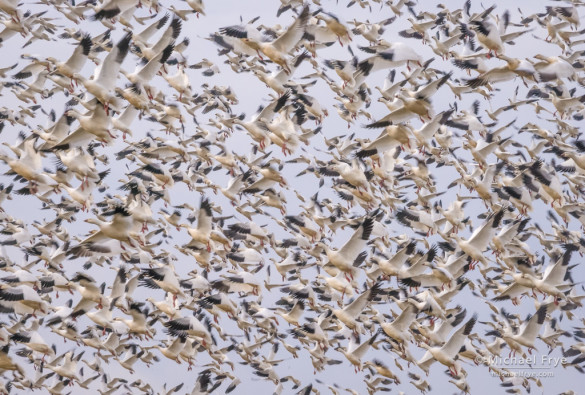
Formation of Ross’s geese taking flight, San Joaquin Valley, CA, USA; 1/250th sec. at f/16, ISO 800
On Wednesday Claudia and I rose early and drove down to the San Joaquin Valley. We spent most of the day photographing birds with our friends G Dan Mitchell, Patty Mitchell, David Hoffman, and Charlotte Hoffman, and had a wonderful time. The human company was great, and we found lots of my favorite bird subjects – the white Ross’s and snow geese.
While composition and light are always vital, some aspects of wildlife photography are very different from landscape photography. With wildlife the subjects are moving, placing greater importance on anticipation, timing, and the ability to make quick decisions about framing and camera settings.
(more…)
by Michael Frye | Dec 13, 2013 | Photography Tips, Yosemite Photo Conditions
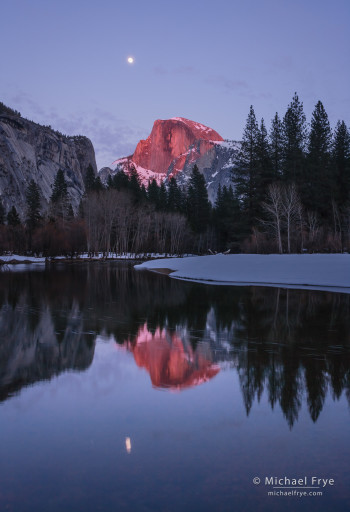
Half Dome and moon at sunset, February 18th, 2008
There’s something magical about the moon. Putting the moon in a photograph adds a sense of mystery and timelessness, and can elevate an otherwise ordinary scene into something special. Ansel Adams confessed to being “moonstruck,” and I suppose I am too.
The moon will be full next Tuesday (at 1:28 a.m. here on the west coast), and I’m sure many photographers will be trying to capture a rising or setting moon during the coming days, so I thought I would share some ideas about photographing the full moon, and clear up some misconceptions.
Misconception #1
One misconception is that moonrise or moonset photos are taken at night. They’re not: they’re almost invariably made near sunrise or sunset. After dark the contrast between the moon and the landscape is too great, and a good exposure for the moon will make the landscape completely black, while a good exposure for the landscape will wash out the moon. Around sunrise and sunset it’s possible to balance the light between the moon and the landscape and get detail in both, yet have a dark enough sky for the moon to stand out clearly.
Misconception #2
Another misconception is that moonrise or moonset photos are made on the date when your calendar says “full moon.” This can work if the terrain is flat, or you’re at a high vantage point. But if there are mountains or ridges blocking your view of the horizon, you’re better off photographing a moonrise one to three days before the full moon, and a moonset one to three days after the full moon. While the moon won’t technically be full, it will look full enough, and be in a better position than on the actual full moon night. Here’s why:
(more…)
by Michael Frye | Dec 5, 2013 | Photography Tips
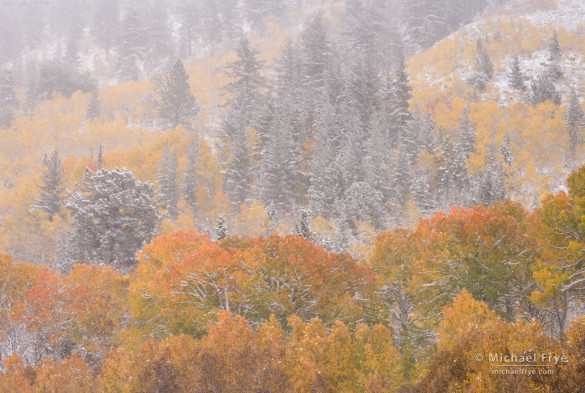
Aspens and pines in an autumn snowstorm, Toiyabe NF, CA, USA; 1/8 sec at f/22, ISO 50
In October I fulfilled a long-time dream: to photograph autumn aspens in the snow. I posted one photograph from that snowy day here, and two more from the following morning here. But I made a lot of other images during that storm, and now finally have a chance to show you some of them.
On that snowy October day it was a challenge to keep my camera dry, keep snow and water drops off the lens, and stay warm myself. But it was a rare opportunity, and I didn’t want to wait until the snow stopped, because the falling snow itself gave the photographs an ethereal quality, almost like fog.
(more…)
by Michael Frye | Nov 26, 2013 | Composition, Photography Tips, Vision and Creativity
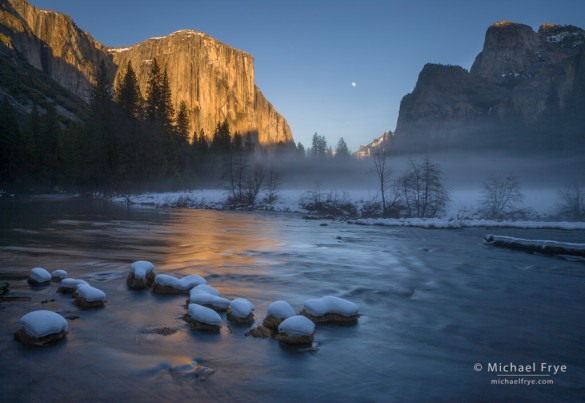
Moon rising between El Capitan and Cathedral Rocks from Valley View. What’s the least interesting part of this image?
The best compositions are simple; they present only the essentials, and leave out extraneous clutter. The most common mistake in photography – by far – is including too much in the frame. Anything that’s not adding to the photograph’s message is detracting from it.
To help simplify your compositions, ask yourself, before you press the shutter, “What’s the least interesting part of this photograph?” Try to identify the weakest area of your composition, and find a way to get rid of it. Then, once you’ve done that, ask the same question again: “Now, what’s the least interesting part of this image?” And get rid of that. And keep doing that until there’s nothing left that you could possibly cut out without losing something vital.
To give you some practice, look at the photograph above. What’s the least interesting part of that image? And if you got rid of that, what would be next – what’s the next least interesting part of the photograph?
I’ll give you a minute to think about it. When you’re ready, take a look at this next photograph, and answer the same question: what’s the least interesting part of this image?
(more…)
by Michael Frye | Nov 19, 2013 | Composition, Photography Tips, Vision and Creativity
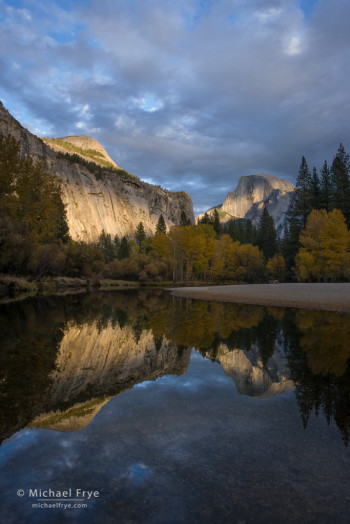
Half Dome and the Merced River, 4:28 p.m.
Is it better to be active or static? To change your location and composition to suit the light, or hope that the light changes to suit your composition?
There’s this persistent myth that Ansel Adams would camp for days at one spot, waiting for the right light. Ironically, this myth is often repeated in relation to Clearing Winter Storm, which was made at Tunnel View, only a few miles from his warm home and comfortable bed in Yosemite Valley. In fact Ansel wrote, “I have always been mindful of Edward Weston’s remark, ‘If I wait for something here I may lose something better over there.’ I have found that keeping on the move is generally more rewarding.”
I have also found that keeping on the move is more rewarding. I’ve sometimes regretted moving, but more often regretted staying when I ignored the inner voice that told me the light would be better elsewhere. And when I do find myself in the right place at the right time, I’ve found that it pays to stay active with my camera and my compositions, and not get lazy about changing lenses or camera positions. If I decide in advance what my composition should be, and stick with that no matter what, I’ll probably miss some great opportunities.
(more…)
by Michael Frye | Nov 13, 2013 | Photography Tips
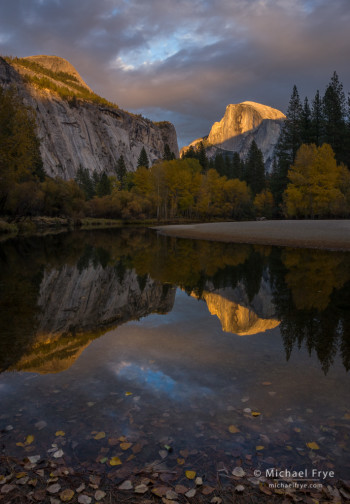
Half Dome and the Merced River, late afternoon, autumn, Yosemite NP, CA, USA
Ansel Adams used to say that “chance favors the prepared mind.” His point was that photographs like Moonrise Hernandez and Clearing Winter Storm weren’t lucky accidents; he was able to capture those moments because he had honed his eye and his photographic technique, and was able to apply those skills when a special opportunity presented itself.
Last night a private workshop student and I had an opportunity to test our mental preparation. We got lucky, as the sun broke through a layer of clouds late in the afternoon. For 45 minutes we watched and photographed a spectacular light show, with beams of sunlight first illuminating the cottonwood trees along the Merced River, then moving upward to reach the Royal Arches, North Dome, and Half Dome itself.
Every landscape photographer hopes to get lucky and capture a beautiful light display like that. But when it happens, will you be prepared? Will you be able to do justice to the gift that’s presented to you?
The first part of that preparation comes with being in the right place at the right time. Luck plays a role here, of course, but so does the ability to anticipate and predict the weather.
(more…)














